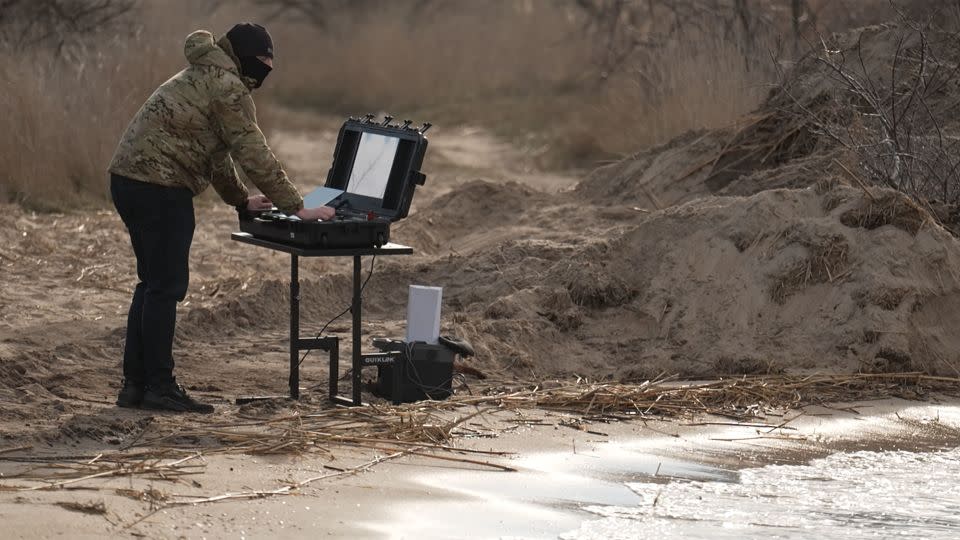A Ukrainian pilot outlines how drones powered by jet skis sunk a Russian warship
All it took was six sea drones, powered by jet skis, to fell a Russian guided missile ship last week, according to a rare interview with the secretive Ukrainian unit behind the attack.
Ukraine’s Defense Intelligence said at the time that the small Russian warship, the Ivanovets, suffered multiple hits to its hull before it was sunk by drones in an inlet on the Russian-occupied Crimean Peninsula.
One of the drone pilots behind the attack told CNN that ten “MAGURA” drones were used in the attack, six of which hit and ultimately sunk the Russian warship – the latest embarrassing loss for Russia’s Black Sea fleet.
The “MAGURA” drones are only a few meters long and powered by jet skis, the pilot said, but they have a large range of around 800 kilometers (nearly 500 miles), giving his unit freedom to launch their drones from across large swathes of Ukraine’s coastline for missions against Crimean targets.
The pilot, identified as call sign “13,” is a member of a special unit in Ukraine’s defense intelligence agency (GUR), which has been linked to a number of attacks on Crimea and into Russia itself, often using drones to hit far beyond the range of conventional weapons of Ukraine’s arsenal.
Night-time footage released by the Ukrainians showed Russians firing at the drones as they raced towards the Ivanovets, before at least two drones struck the side of the ship, disabling it and causing massive explosions.
The footage includes a striking scene of what appears to be the bow of the Ivanovets sticking out of the water as it sinks to the bottom of Lake Donuzlav.
CNN could not independently verify Ukraine’s claim and which vessel was struck and when. There has been no official comment from Russia about Ukraine’s claims.
Calls for more drones
Kyiv is increasingly turning to drones to level the playing field with Russia, with a string of drone attacks hitting strategic targets in Russia in recent weeks.
Moscow’s oil and gas infrastructure has come under threat, with a drone attack on a Russian oil terminal about 100 kilometers (62 miles) west of Saint Petersburg.
Russians “started waking up at night during explosions,” Ukraine’s defense intelligence chief Kyrylo Budanov told CNN in late January. “They see the real picture of war.”

On the battlefield too, Ukraine’s top general has called for more widespread use of drones, both to save the lives of Ukrainian troops and to negate Russia’s material advantage in arms and ammunition.
“It is these unmanned systems – such as drones – along with other types of advanced weapons, that provide the best way for Ukraine to avoid being drawn into a positional war, where we do not possess the advantage,” Ukraine’s Commander-in-Chief of the Armed Forces, Valerii Zaluzhnyi, wrote in a CNN op-ed last week.
“In short, this means nothing less than the wholesale redesign of battlefield operations – and the abandoning of outdated, stereotypical thinking,” he added.
Since Russia’s takeover of Crimea in 2014 – and following further losses after Russia’s 2022 invasion – Ukraine no longer has a functioning navy in the Black Sea. But the sinking of the Ivanovets is another victory in Ukraine’s campaign against Russia’s Black Sea Fleet.
The most notable of its strikes was the attack on the Moskva in April 2022, which forced Russia to change the way it operates close to areas controlled by Ukraine.
‘Jeweler’s work’
The impact of the drones is impressive but it’s delicate work, said the pilot.
“The main thing is to feel the drone,” he told CNN. “If you squeeze it a little, you can lose control of the drone. I would say it’s like jeweler’s work.
Controlled from afar via a Starlink connection, the drones can also be pre-programmed for the long journeys across the Black Sea.
A pilot is constantly monitoring the drone’s passage, he said, with the final run into the targets often controlled manually.
The drone’s 250kg (551lb) payload can be increased to 300kg, he added, “but there is no need to do so.” Even against some of the toughest ships of Moscow’s Black Sea fleet, the drones have proved their effectiveness.

At almost six meters long, the drones are imposing out of the water. But once afloat, they make a hard target for defending Russians.
“They are quite difficult to see, especially in the open sea. This size makes it difficult to control it because the sea is choppy but it also makes it much harder for the enemy to hit us,” he said.
The weaponry aboard Russia’s warships wasn’t designed with drones in mind, forcing targets like the IVAN to use cannons better suited to duels with other ships, the pilot said.
Video of the attack shows rounds hitting the water as the drones home in on the Ivanovets. The ammunition is unable to stop the incoming bombs.
At a demonstration of the drones on the Black Sea, CNN saw one drone – identical to those used against the Ivanovets – pull off tight turns at speed on autopilot. It’s agile by design, the pilot said.
“No warship can be as manoeuvrable as these drones,” he added.
For more CNN news and newsletters create an account at CNN.com


